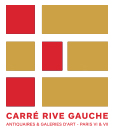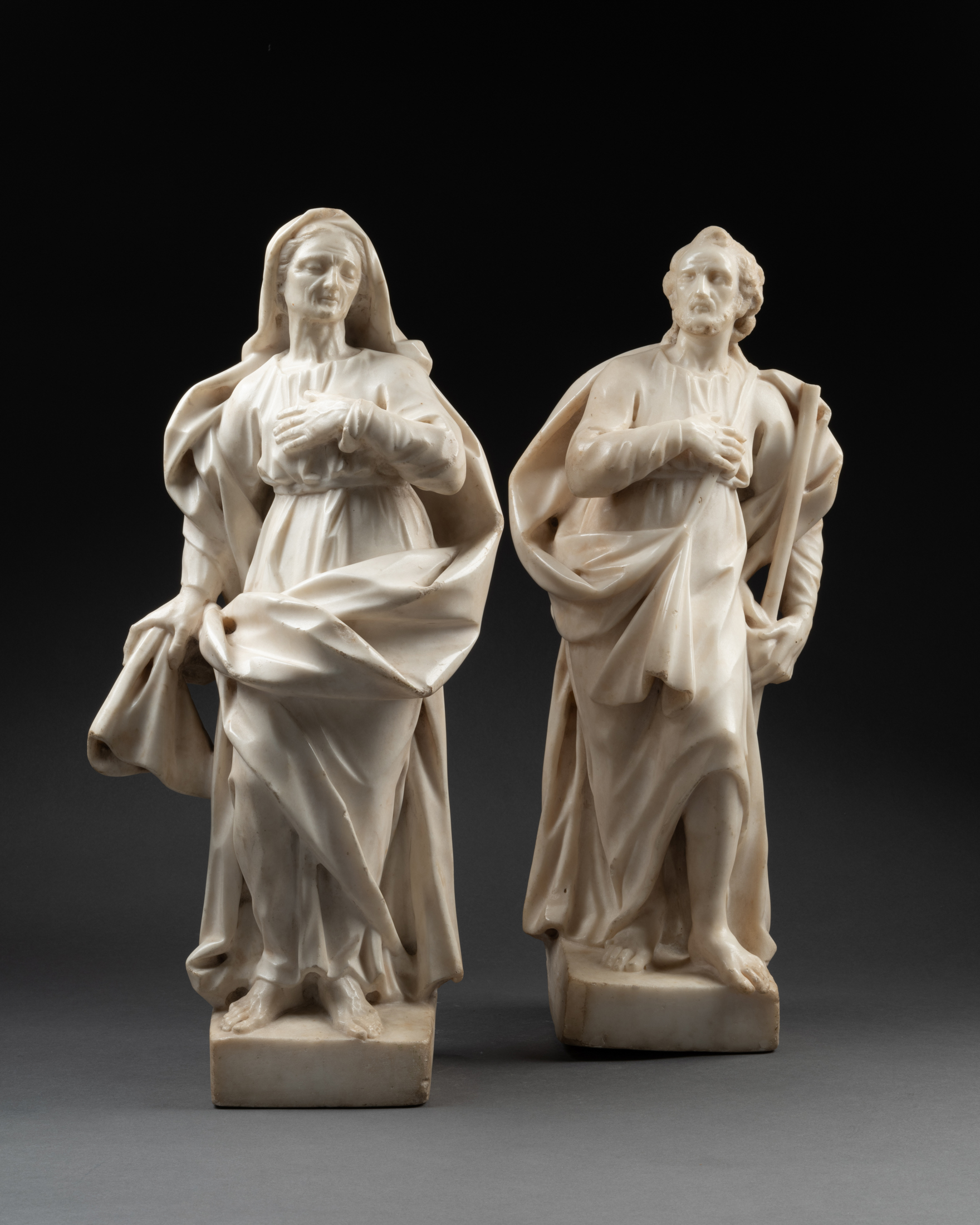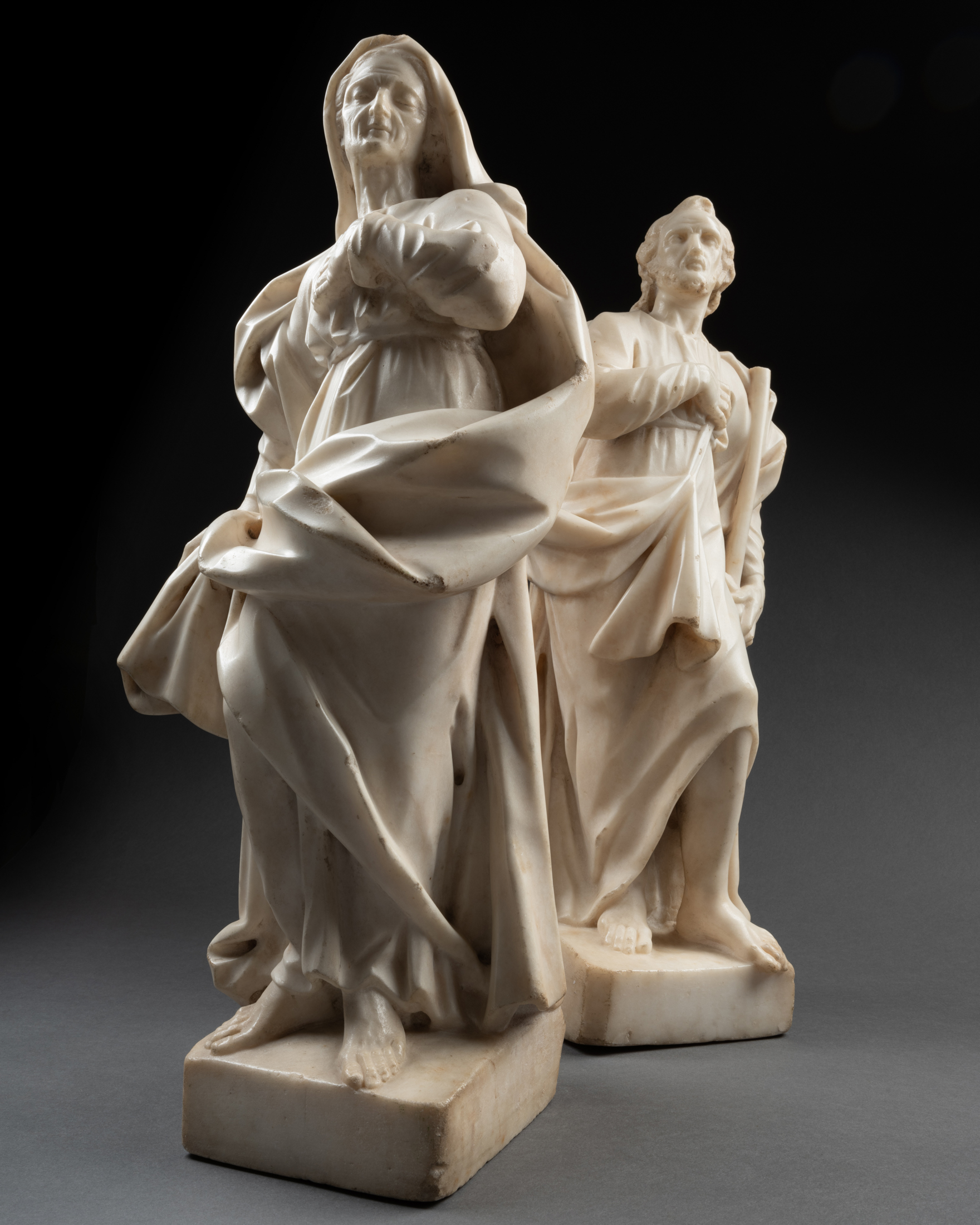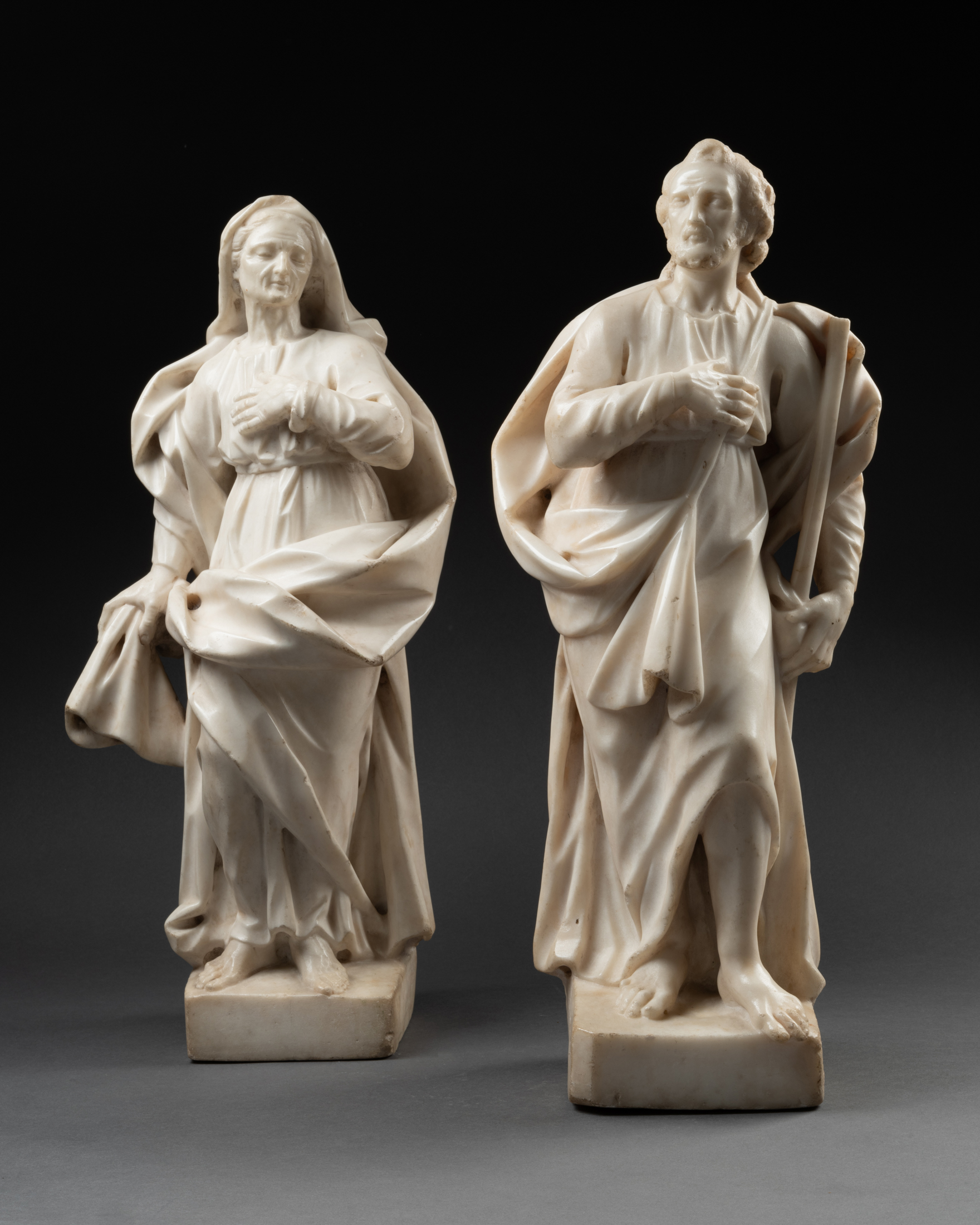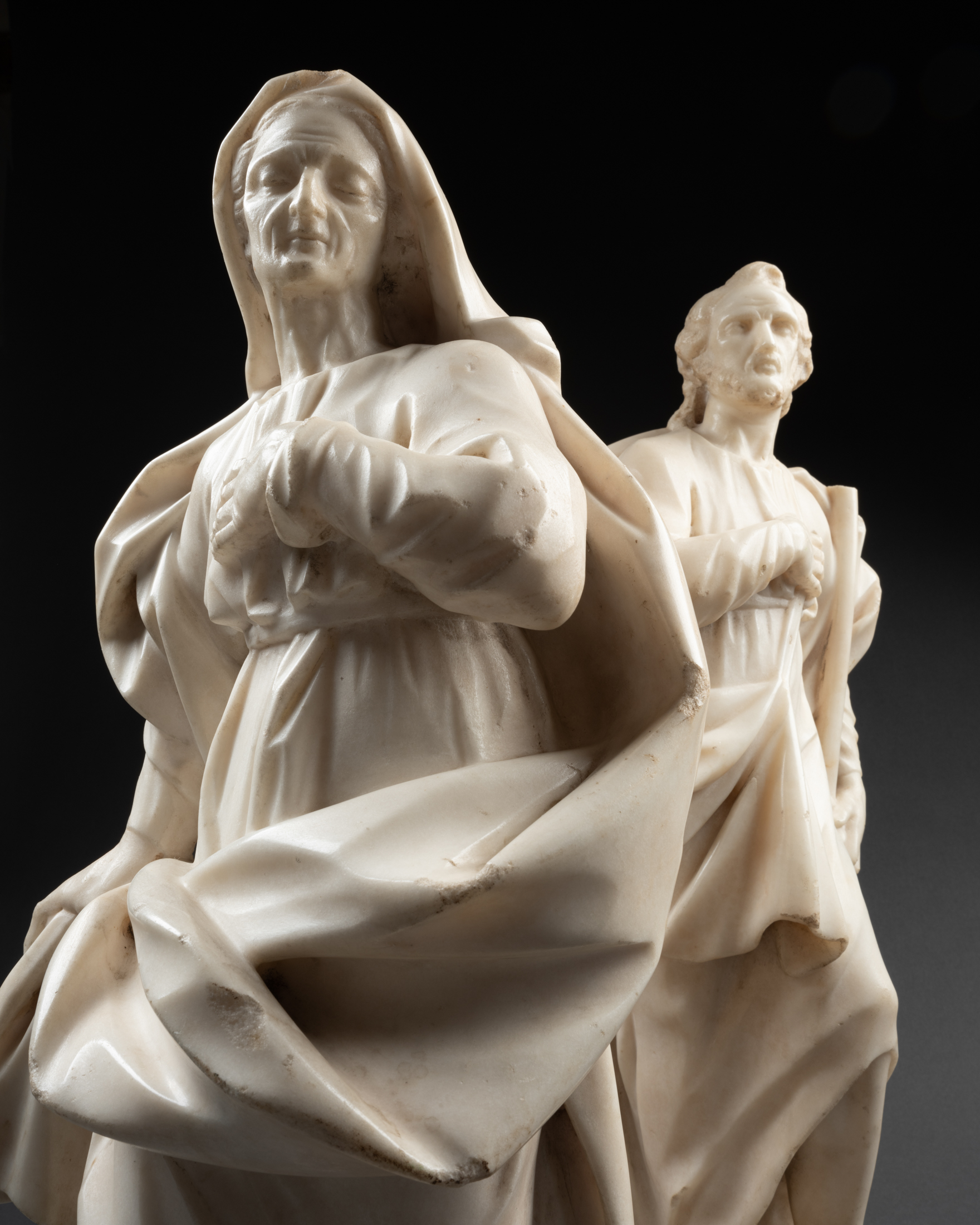Description
Cette belle paire de sculptures en marbre représente les saints Anne et
Joachim, parents de la Vierge. Absents des textes canoniques bibliques, les figures et l’histoire de ces saints proviennent du récit apocryphe grec du Protévangile de Jacques, puis de son adaptation latine l’Evangile du Pseudo-Matthieu. C’est toutefois au XIIIe siècle, grâce à la propagation de la Légende dorée par Jacques de Voragine, que leur image s’installe dans la culture populaire.
D’après les textes, Anne, fille d’Akar et Émérencie de la Tribu de Lévi, serait née à Bethléem vers l’an 55 avant J-C. Elle est décrite comme une femme pieuse et longtemps stérile. Sa figure fait souvent référence, dans les apocryphes, à son homonyme vétéro-testamentaire Hannah, mère de Samuel, prophète et dernier juge d’Israël. Joachim remonte quant à lui à la Tribu royale de Juda, descendant de la lignée du roi David. Pieux et charitable, il est pasteur de brebis à Nazareth puis s’occupe plus tard du cheptel de son père près de Jérusalem.
Les récits rapportent que leur rencontre a lieu à Jérusalem. Joachim se rendait régulièrement au Temple car il s’occupait de sa décoration. Alors qu’il lavait ses moutons dans la piscine de Bethesda, Anne se trouvait près de la Porte des brebis située juste à côté. Après vingt ans de mariage, le couple décide de se séparer car ils n’arrivent pas à enfanter. Désespérés par leur situation qui pose de nombreux problèmes dans leurs vies religieuse et personnelle, ils jeûnent et prient chacun de leur côté dans l’espoir d’être entendus par Dieu. Quarante jours plus tard, un ange leur apparaît séparément afin de leur transmettre qu’ils seront bientôt parents.
Leur Rencontre miraculeuse à la Porte dorée, après l’annonce de la prochaine naissance de leur enfant, compte parmi les représentations les plus populaires de ces deux saints. Au XIIIe siècle, la postérité légendaire de sainte Anne se diffuse et en découle le culte de la Sainte Parenté qui devient également une iconographie populaire des saints parents de la Vierge, en opposition à celle de la Sainte Famille. Leur culte décline progressivement au XVIe siècle dans les territoires touchés par la Contre-Réforme. Toutefois, en Italie, sainte Anne et saint Joachim continuent d’être représentés et vénérés. Ils sont les saints patrons des grands-parents et de la fécondité des couples.
Nos oeuvres sont sculptées sur trois faces et devaient donc être destinées à de petites niches, peut-être pour une chapelle dédiée aux deux saints. Saint Joachim est non finito : sa chevelure ne semble pas terminée. La technique du non finito apparaît pour la première fois dans les créations de Donatello qui désirait mettre en avant les intensités spirituelle et dramatique des sujets représentés. Il s’agit donc, pour certains artistes, d’une volonté artistique, d’une technique utilisée
comme moyen d’expression. Pour d’autres, comme Michel-Ange, il semble que le non finito apparaisse plus comme une esthétique de l’inachevé qui résulte de la difficulté pour l’artiste d’atteindre la perfection.
L’artiste de nos saints Anne et Joachim emploie également la technique du trépan, sorte de foret actionné à la main au moyen d’un archet. Cet outil est employé depuis l’Antiquité afin d’atteindre des renfoncements, dégager des parties difficiles d’accès et dégrossir des gorges de faible diamètre en formant des cavités cylindriques. Lent mais précis, le trépan est destiné aux endroits très fragiles et à des matériaux durs comme le bois, la pierre et le marbre. La technique du trépan permet d’apporter mouvement et profondeur à l’ensemble.
Elles s’inscrivent dans la production de sculptures d’églises réalisées par des artistes baroques italiens à la fin du XVIIe siècle. Le sculpteur Orazio Marinali (1643-1720) a produit plusieurs oeuvres de ce type dont certaines sont exposées aujourd’hui au musée de la Ville de Crémone. Les dimensions, l’expression et la gestuelle des mains apportent une certaine dramatisation, typique de la sculpture baroque, et rappellent les caractéristiques de nos saints Anne et Joachim.
A San Gregorio da Sassola, un artiste probablement du cercle du Bernin a réalisé les sculptures pour le couvent Santa Maria Nuova. Deux d’entre elles figurent sainte Anne et saint Joachim avec cette même dramatisation exprimée par la gestuelle des personnages et par le mouvement des drapés et de leur corps.
Nos deux sculptures s’inscrivent donc dans la production du baroque italien de la fin du XVIIe siècle avec un mouvement exagéré, des effets dramatiques, une tension dans l’expression et une certaine exubérance des formes, comme la main de sainte Anne dont la taille contraste avec le reste du corps. Comme le disait Philippe Beaussant, l’époque baroque était « un monde où tous les contraires seraient harmonieusement possibles ».
________________________________________
This beautiful pair of marble sculptures represents Saints Anne and Joachim, parents of the Virgin Mary. Absent from the biblical canonical texts, the figures and story of these saints come from the Greek apocryphal account of the Gospel of James, then from its Latin adaptation, the Gospel of Pseudo-Matthew. However, it was in the 13th century, thanks to the propagation of the Golden Legend by James of Voragine, that their image became established in popular culture.
According to the texts, Anne, daughter of Akar and emeritus of the Tribe of Levi, was born in Bethlehem around 55 BC. She is described as a pious woman who was barren for a long time. Her figure is often referred to, in the apocrypha, as her Old Testament namesake Hannah, mother of Samuel, prophet and last judge of Israel. Joachim, on the other hand, goes back to the Royal Tribe of Judah, descending from the line of King David. Pious and charitable, he was a shepherd of sheep in Nazareth and later took care of his father’s flock near Jerusalem.
The stories say that their meeting took place in Jerusalem. Joachim was a regular visitor to the Temple because he was involved in its decoration. While he was washing his sheep in the Pool of Bethesda, Hannah was near the Sheep Gate next door. After twenty years of marriage, the couple decided to separate because they could not bear children. Desperate for their situation, which posed many problems in their religious and personal lives, they fasted and prayed on their own in the hope that God would hear them. Forty days later, an angel appeared to them separately to tell them that they would soon be parents.
Their miraculous meeting at the Golden Gate, after the announcement of the forthcoming birth of their child, is one of the most popular representations of these two saints. In the 13th century, the legendary posterity of St. Anne spread and the cult of the Holy Kinship was born, which also became a popular iconography of the holy parents of the Virgin, in opposition to that of the Holy Family. Their cult gradually declined in the sixteenth century in the territories affected by the Counter-Reformation. However, in Italy, Saint Anne and Saint Joachim continue to be represented and venerated. They are the patron saints of grandparents and of the fertility of couples.
Our works are carved on three sides and were therefore intended for small niches, perhaps for a chapel dedicated to the two saints. Saint Joachim is non finito: his hair does not seem to be finished. The technique of the non finito appears for the first time in the creations of Donatello who wished to emphasize the spiritual and dramatic intensity of the subjects represented. It is thus, for certain artists, an artistic will, a technique used as a means of expression. For others, like Michelangelo, it seems that the non finito appears more like an aesthetic of the unfinished which results from the difficulty for the artist to reach the perfection.
The artist of our saints Anne and Joachim also uses the technique of the drill bit, a kind of hand-operated drill with a bow. This tool has been used since ancient times to reach recesses, clear hard-to-reach parts and rough out small diameter grooves by forming cylindrical cavities. Slow but precise, the drill bit is intended for very fragile areas and hard materials such as wood, stone and marble. The technique of the drill bit allows to bring movement and depth to the whole.
They are part of the production of church sculptures made by Italian Baroque artists at the end of the 17th century. The sculptor Orazio Marinali (1643-1720) produced several works of this type, some of which are now on display in the Cremona City Museum. The dimensions, the expression and the gestures of the hands bring a certain dramatization, typical of Baroque sculpture, and recall the characteristics of our Saints Anne and Joachim.
In San Gregorio da Sassola, an artist probably from Bernini’s circle made the sculptures for the Santa Maria Nuova convent. Two of them represent St. Anne and St. Joachim with the same dramatization expressed by the gestures of the characters and by the movement of the draperies and of their bodies.
Our two sculptures are thus part of the production of the Italian Baroque of the end of the XVIIth century with an exaggerated movement, dramatic effects, a tension in the expression and a certain exuberance of the forms, like the hand of Saint Anne whose size contrasts with the rest of the body. As Philippe Beaussant said, the Baroque period was « a world where all the opposites would be harmoniously possible ».
